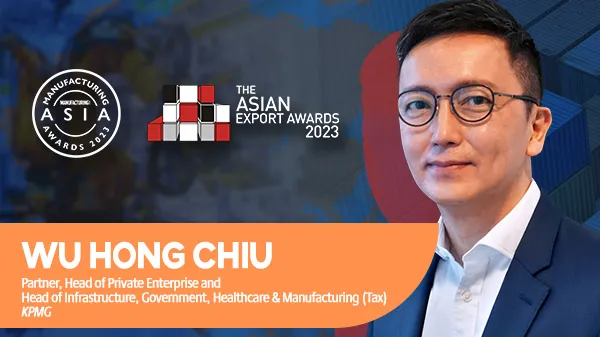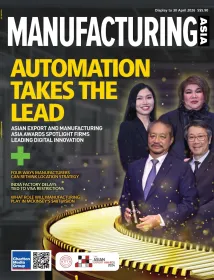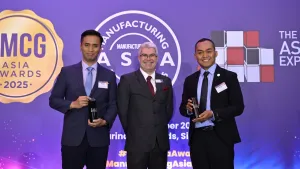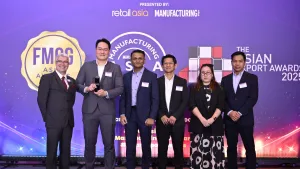
KPMG’s Chiu Wu Hong: Diversification, digitalisation, sustainability vital in enhancing supply chains for resilience, efficiency
Discover the KPMG Partner’s expert insights on supply chain resilience, tax strategies, operational challenges, sustainability, and digital transformation.
Navigating the complexities of global supply chains, tax regulations, and sustainability practices in the manufacturing and export sectors can be a daunting task. However, with careful planning and the right expertise, businesses can optimise their operations and contribute to a more sustainable future.
Chiu Wu Hong, Tax Partner and Head of Private Enterprise in KPMG in Singapore, brings over 30 years of Singapore and international tax experience to the table. Chiu Wu Hong's professional journey has been marked by a commitment to excellence in tax compliance and advisory services. With a diverse clientele, he specialises in tax-efficient structures, cross-border transactions, and mergers and acquisitions for both local and multinational companies. His leadership extends to the infrastructure, manufacturing, transport, logistics, and private enterprise sectors at KPMG Singapore.
Beyond his professional accolades, Wu Hong has shared his expertise through articles in tax journals and as a frequent speaker on tax-related topics.
Wu Hong has not only been an invaluable asset to KPMG but also a distinguished judge at the Manufacturing Asia Awards and the Asian Export Awards.
In this article, Wu Hong emphasised the need for resilient and efficient supply chains, made possible through diversification of suppliers and optimisation of network structures, amongst other factors. He also discussed challenges within the manufacturing and export sectors, as well as possible ways to address these challenges.
Given your experience in advising clients on global supply chain strategies, what are some key factors that manufacturers should take into account when optimising their supply chains for efficiency and cost-effectiveness, especially in light of recent global disruptions?
In recent years, global disruptions such as the COVID-19 pandemic have underscored the need for resilient and efficient supply chains. Manufacturers should therefore consider the following key factors:
Diversification of Suppliers. Recent events such as the semiconductor chip shortage which led to production delays for car manufacturers, have demonstrated the risks of relying on a single supplier. Diversification is a key strategy for manufacturers to reduce their risk and improve supply chain resilience through sourcing materials and components from multiple suppliers in different regions, to avoid disruptions caused by factors such as production issues, natural disasters, political instability etc. The “China Plus One strategy” is an extension of the diversification strategy that involves moving some production out of China to other countries in Asia or other regions of the world. By moving some production out of China, manufacturers can reduce their reliance on a single country for their supply chains. Whilst this first came about to reduce expenditure by moving production to lower-cost countries, in recent years, companies have pursued this business model to protect their supply chains.
Leverage on Network Optimisation through Digitalisation and Data Analytics. A well-optimised supply chain network enables manufacturers to optimise inventory management, reduce lead time and service delivery time, and meet customer expectations more effectively. The development of network scenarios can help to establish the best decisions whilst achieving cost-effectiveness through examining inventory shifts, consolidating or eliminating different distribution facilities, and rationalising transportation modes. Companies like Amazon have successfully leveraged on data analytics to optimise inventory management and anticipate customer demand.
Increase end-to-end supply chain visibility. Supply chain visibility is the ability to track different goods and/or products in transit, giving a clear view of inventory and activities. It enables manufacturers to improve customer service and cost controls through the management of inventory in motion, proactive status updates, limiting disruptions, and risk mitigation. The future of supply chain visibility includes deploying a “control tower” within the organisation’s centralised system that collects and analyses data from across the supply chain network. This data can be used to identify and address potential disruptions, optimise inventory levels, and improve transportation efficiency. With predictive and prescriptive data analytics, control towers enable manufacturers to identify trends and potential problems more effectively.
Regulatory Compliance. Recent trade tensions have led to tariff changes and trade policy shifts. Engaging the right professionals would allow manufacturers to be informed about these changes which will continuously help optimise their supply chains and avoid unexpected costs.
Sustainable Practices. Brands like IKEA have committed to becoming more sustainable, not just in their products but also in their supply chains. Sustainability, in the long term, can reduce costs and enhance reputation.
The impact of implementing these strategies will help businesses to increase supply chain resilience, reduce production downtime, lower inventory holding costs, and
enhance customer satisfaction.
What recent developments or trends in tax law and regulations do you believe are particularly relevant for manufacturing companies to stay informed about?
Manufacturing companies should monitor the following developments in tax law and regulations:
OECD’s Base Erosion and Profit Shifting (BEPS) initiative. Probably the most talked about topic in recent times are the BEPS Pillar Two Model Rules. These rules are designed to ensure large multinational enterprises (MNEs) pay a minimum level of tax (i.e. 15%) on the income arising in each jurisdiction where they operate. Hence, MNEs (including manufacturing companies) enjoying tax incentives or paying lower than the minimum level of tax in each jurisdiction where they operate, need to consider the impact of these new rules and consider the need to optimise their supply chains to minimise their overall tax impact. Furthermore, recent OECD developments emphasise the importance of aligning transfer pricing practices with value creation. Companies need to therefore ensure they have robust transfer pricing documentation in place.
Incentives for R&D and Innovation. Many countries in Asia offer tax incentives to encourage research and development activities. Staying informed about these incentives can help manufacturers reduce tax liabilities whilst fostering innovation.
For example, Enterprise SG offers the Enterprise Development Grant, which supports local enterprises to innovate, grow, and transform their businesses. Singapore’s Budget 2023 also introduced the Enterprise Innovation Scheme, which helps small, growing businesses defray the cost of their innovation activities.
Supply Chain Structuring. Utilising tax-efficient supply chain structures, such as centralising procurement or the use of regional hubs, can optimise taxes and customs duties. Recent trade tensions, like the US-China trade dispute, have prompted companies to reassess their supply chain structures.
Environmental Taxation. Several countries have introduced environmental taxes to incentivise green practices. For example, Singapore introduced a carbon tax to encourage companies to reduce emissions. Manufacturers can benefit from carbon tax credits as well as from the application for environmental grants and incentives (e.g. Energy Efficiency Fund, 3R Fund) by adopting eco-friendly practices.
Implementing tax strategies to address these developments can result in reduced tax liabilities, increased cash flow, and enhanced competitiveness in the global market.
With your leadership role at KPMG Singapore, you've likely encountered various challenges faced by private enterprises. What are some common financial and operational challenges that manufacturing businesses encounter, and how can they address them effectively?
The more prominent financial and operational challenges that manufacturing businesses encounter may include:
Cost Control. Manufacturers often face pressure to cut costs whilst maintaining quality. Cost can be controlled through lean manufacturing practices, adopting automation, and optimising supply chains.
Supply Chain Disruptions. Events like the Suez Canal blockage and the pandemic disrupted global supply chains. To address the challenges, companies should invest in scenario planning, dual sourcing, and digital supply chain monitoring.
Talent Management. The gap between demand and supply of skilled workforce is a global issue. Manufacturers can address this by investing in workforce development, upskilling, and automation to augment human labour.
Technology Adoption. Manufacturers should invest in industry 4.0 technologies, such as the Internet of Things (IoT) and artificial intelligence (AI), that offer significant opportunities for efficiency improvements and innovation. At the same time, manufacturers must ensure that employees are well-trained to use the tools efficiently.
Cyber security. Technology adoption goes alongside the increase in cyberattacks. At present, cybercriminals are more sophisticated when it comes to infiltrating supply chains to damage or steal from businesses. The supply chain can offer vulnerabilities that provide external parties with a pathway to get into the company’s systems, particularly via the supplier network. This issue could be addressed by: implementing cyber risk assessments of third parties and the functions or activities within the supply chain; funding and implementing AI or machine learning (ML) as part of the standard onboarding process of new suppliers; and educating staff on cyber security risks to prevent cyberattacks.
Environmental Sustainability. Sustainability challenges, such as reducing carbon emissions and waste, can be addressed by implementing eco-friendly practices. Companies can reduce energy costs through energy-efficient processes and renewable energy adoption.
The impact of addressing these challenges includes improved cost-efficiency, increased resilience, enhanced product quality, a reduction in cyber-attacks, and alignment with sustainability goals.
With your experience advising clients in the manufacturing sector, how do you see sustainability and environmental responsibility shaping the strategies of modern manufacturing companies, and what role does tax planning play in encouraging environmentally friendly practices?
Sustainability and environmental responsibility are increasingly influencing manufacturing strategies, as they are key initiatives that businesses must take into account in order to stay relevant and competitive.
Examples of tax planning strategies that can encourage environmentally friendly practices are:
Energy Efficiency. Manufacturers like Toyota are investing in energy-efficient technologies in their factories. Tax incentives for renewable energy adoption and energy-efficient equipment can make these investments financially attractive.
Tax Credits and Incentives. Governments globally are offering tax credits and incentives for green investments. For example, Singapore offers the Enterprise Financing Scheme - Green grant, which focuses on helping Singapore companies develop capabilities and capture growth opportunities within the green economy. Companies should seek to tap into these grants and incentives to maximise their tax efficiencies.
Carbon Pricing. Due to the increase in carbon taxes and implementation of carbon credits, manufacturing companies can consider applying or developing internal carbon pricing tools or methodologies to manage the financial impact of carbon pricing schemes.
Reporting and Transparency. Due to the increase in tax transparency both in the APAC region and globally, it may be expected that governments will consider implementing a tax transparency framework and tax disclosure requirements (similar to DAC6 in the EU). Manufacturing companies should closely monitor any developments in these areas to identify where tax transparency or tax disclosure exposure may arise. In addition, aligning tax and sustainability reporting can enhance transparency and demonstrate a commitment to environmentally friendly practices. This, in turn, can improve stakeholder trust and potentially attract responsible investment.
The above-mentioned factors need to be considered by manufacturing companies in order to increase cost savings and improve brand reputation, which, in turn, generates a competitive advantage in an increasingly eco-conscious market.
In your role as Head of Private Enterprise in KPMG Singapore, how do you envision the future of private manufacturing enterprises in the context of digital transformation, and what strategies can they adopt to harness technology for their growth and competitiveness?
I believe that the future of private manufacturing enterprises lies in harnessing the following key digital transformation:
Automation. Companies like Foxconn have successfully implemented robotics in their factories to increase efficiency and reduce labour costs. Automation does not necessarily replace the need for human efforts but helps to streamline operations and increase productivity by taking over time-consuming and monotonous tasks. This trend is expected to continue, with more manufacturers adopting automation as it increases supply chain performance and velocity as well as reduces human error.
However, since automation technology, equipment, and robotics can be costly, many e-commerce businesses rely on a tech-enabled 3PL that has made investments in automation to optimise their supply chain.
Data Analytics. Advanced analytics, such as AI, can provide insights into manufacturing processes and customer preferences. Manufacturers can optimise production schedules and customise products based on real-time data.
IoT Integration. IoT sensors can monitor equipment health and predict maintenance needs. This reduces downtime and improves overall equipment effectiveness.
Supply Chain Visibility. Blockchain technology can enhance transparency, traceability, and improve cross-collaboration in the supply chain, which aids in reducing errors and fraud whilst increasing trust amongst partners and consumers.
For businesses to grow and remain competitive, it is crucial to align technology initiatives with business outcomes to ensure the best and right investment is made for the company. Businesses need to be customer-centric and create change from within the organisation through driving culture first and promoting innovation, adaptability, and agility in the workforce.
The impact of these strategies includes increased production efficiency, faster time-to-market, better customer satisfaction, and enhanced competitiveness in the global marketplace.
As a judge at the Manufacturing Asia Awards and Asian Export Awards, what qualities or innovative approaches do you personally value when evaluating standout initiatives in the manufacturing and export sectors?
I value business initiatives that demonstrate the following qualities:
Innovation. Innovative approaches that push the boundaries of what is possible in manufacturing and export processes, leading to breakthroughs in efficiency or sustainability.
ESG. Commitment to sustainability by reducing environmental impact, promoting fair labour practices, and engaging in socially responsible activities.
Market Adaptability. Initiatives that showcase the ability to pivot and adapt to changing market conditions, ensuring competitiveness in dynamic markets.
Collaboration. Initiatives that foster collaboration amongst stakeholders, whether it's partnering with local communities, suppliers, or industry peers, leading to mutual benefits and positive outcomes for all.
These qualities and innovative approaches not only reflect forward-thinking leadership but also contribute to the broader goals of sustainable growth and prosperity in the manufacturing and export sectors.


















